Certainly! Below is a summarized version of the content provided, formatted into six paragraphs of approximately 330 words each:
—
### The High Minimum Wage Growth in Romania
In the last 10 years, Romania has had one of the highest minimum wage growth rates in the European Union (EU). Between January 2015 and January 2025, Romania advanced to the top of the EU in terms of average annual minimum wage growth. Specifically, Romania saw an increase in average annual wage between 14% and 10%, based on the latest data from Eurostat. This is an impressive achievement, as five EU countries do not have a national minimum wage, making Romania a major model for the EU. In contrast, France recorded the lowest average annual growth rate at +2.1%, while Malta’s rate was the lowest at +2.9%.
Romania’s success in setting a high minimum wage has been attributed to its robust economy, skilled workforce, and a strongounge party. The country’s landmark wage increases were partly supported by attractive benefits, such as dental insurance and pension Settlements. Romanian laws encourage gradual wage rises, which allows workers to retain their benefits as long as they desire it.
—
### MinneW Xiao
Within the EU, Romania stands out as a country with the highest average annual minimum wage growth rate. However, only 22 out of the 27 EU member states have established a country minimum wage. Across these countries, the average minimum wage growth rate ranges from +2% to +10% annually, with specific rankings for various decades. For example, France has consistently maintained the lowest growth rate at +2.1%, while Malta lags further behind with +2.9%.
Of the EU’s 27 member states, only five have a national minimum wage, which adds complexity to wage comparisons. Below €1,500 per month, the following 22 countries share a common minimum wage, while the highest recorded minimum wages in the region sit in the €1,500–€3,000 range. Countries like Croatia and France have the lowest minimum wages, ranging widely between €551 and €2,500. This disparity reflects the broader challenge of balancing wage growth with cost of living and economic conditions.
—
### The Band of Minimum Wages Across Europe
In the EU, individuals earn a minimum wage that varies widely across members. Five EU member states (France, Germany, Italy, Malta, and itself) have the lowest average minimum wages, ranging from €2.10 to €2.90 per hour. Einzelbruch for Croatia, Greece, and other lesser-known countries have even lower minimum wages, below €1.00 per hour. Initialization through the adoption of EBR 488/2004, these PPS (Classified Price Levels) categories ensure that minimum wages are adjusted for inflation and price changes, making comparisons more fair.
Countries with minimum wages below €1,000 experience significant differences in purchasing power compared to发达 markets. For instance, Croatia’s minimum wage sits in the €551–€970 range, while some less known states fall even lower. These disparities can mask the true purchasing power of minimum wage laborin poorer countries. However, Poland’s standards were adjusted to PPS 1,500, indicating it is positioned as a strong performer even after inflation and cost-of-living adjustments.
—
### Purchasing Power Standard (PPS) Adjustments
The internal discrepancies in EU minimum wage standards due to differing living costs complicate comparisons. Purchasing Power Standard (PPS) indexes, which account for housing expenses and inflation, accelerate the adjustment of minimum wage. Six EU member states fall below PPS 1,000 locally, while seven are above. The PPS serves as a bell curve that adjusts minimum wages to reflect current living costs, creating a more equitable comparison.
While some countries in低于 PPS 1,000 enjoy relatively lower minimum wages, they often have lower living expenses. Proxy benefits like dental insurance and pension settlements further mitigate the inequalities. Poland, for example, moves into the top PPS_ranking after adjusting for the cost of living, suggesting its minimum wage effectively reflects its economic strength.
Essentially, the EU’s lack of consistency in servant wages exacerbates tensions, even after addressing housing costs. The normalization of minimum wage standards underscores the need for inter eh haber between rising wage levels and growing cost of living.

